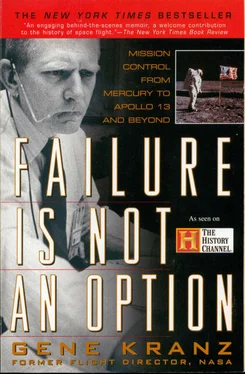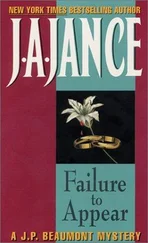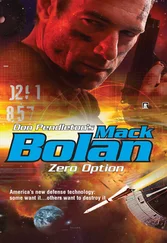Sig Sjoberg took over the four divisions of Flight Operations in 1969 after Kraft became Dr. Gilruth’s deputy director. Sjoberg and Kraft were born to be together. We were sure that Sig’s position as our boss was only temporary and that he would become Kraft’s deputy for the MSC when Gilruth retired and Chris took over.
After a glitchless countdown, the Cape launch team handed Griffin a virtually perfect command module, named Endeavour . Conscious of the importance of science for their mission, Dave Scott, Jim Irwin, and Al Worden named their craft for the ship commanded by Captain James Cook. That Endeavour sailed in 1768 from England to Tahiti to observe the passage of the planet Venus between the Earth and the Sun. The LM was dubbed Falcon, in honor of the Air Force mascot for an all-Air Force crew.
The launch and orbital checkout of the CSM and booster clocked off in the normally intense timeline. After TLI booster engine cutoff a series of critical events takes place for a half hour, starting with the separation of the CSM from the booster, followed by the turnaround and docking with the lunar spacecraft nestled atop the booster. While taking a breather before extracting the LM, Al Worden looked around the cockpit, casually noting, “The main engine thrust light on the entry monitoring system panel is on. I’m not sure when it came on.”
Instantly, GNC Gary Coen snapped, “Flight, Panel 8, have the crew pull both pilot valve circuit breakers.”
Worden replied, “Okay, they’re pulled.”
Gary continued, “Flight, the engine is now safe. The thrust light indicated the CSM main rocket engine was armed and ready to fire.” An engine start signal triggering actual engine ignition during the critical turnaround, docking, and extraction sequence could have crashed the CSM into the LM or the booster. Pausing briefly, Coen continued, “I think we have an electrical short in the engine start circuit.” With MCC’s preliminary diagnosis and the rocket engine now safe, the astronauts continued the timeline, firing the pyros to release the LM and firing thrusters to maneuver away from the booster stage.
The initial hours on the outward journey of a mission are always busy. There are many housekeeping items, and when they are completed the crew and control teams settle into a groove for the three-day transit to the Moon. Every glitch must be closed out so the work is distributed among the teams. Much of the systems analysis work, like determining the cause and cure of this engine electronics glitch, is assigned to the shift that is on duty when the crew is sleeping.
Griffin handed the thrust problem to Windler. After a brief period of troubleshooting, Windler passed the problem to Lunney’s team to develop the workaround procedures. The workaround had to have three parts: protecting against an unplanned engine start, keeping the engine running during the maneuver, and cutting the engine off at the correct time.
Every system on a spacecraft is critical, but when you had to make up your mind whether or not to go into lunar orbit, the service propulsion system (SPS) in the CSM moved to the top of the list. It must work to get into lunar orbit, and once in orbit it was the crew’s ticket home. The SPS design provided redundant electronics, electrical power, and propellant feed systems, but there was only one engine nozzle and a single set of propellant tanks, so any leaks were cause for rapid mission termination.
Mission rules require full redundancy of the engine control electronics systems to enter lunar orbit and to allow LM separation once in lunar orbit. The job fell to Lunney’s team to make sure that the SPS was fully operable. By the end of Lunney’s first shift, troubleshooting limited the problem to the A engine control circuit. The B control circuit was fully operable. Time is one of the most precious resources of flight directors and, for a change, time was on our side during the three-day translunar coast. Lunney’s team GNC, Joe DeAtkine, was short, quiet, young, and unassuming. Flying his first mission as GNC, Joe felt the weight of the world on his shoulders.
A flight control team develops a keen awareness of situations in which someone needs help. Gary Coen and Jack Kamman were on each side of DeAtkine’s shift. Each extended his shift duties so that they overlapped, giving Joe the coaching and mentoring he needed to survive his first crisis. After developing the workaround Joe emerged with the confidence that he could do it on his own the next time.
Griffin executed the maneuver with the amended procedures and, most importantly, met the criteria for continuing the mission. This uncanny ability at assimilating data, making judgments, and balancing risk versus gain reached maturity in Apollo.
The Hadley Rille landing site was in a mountainous region of the Moon well north of the equator and on the edge of a mile-wide canyon. Scott and Irwin guided the Falcon through the descent, surprised to find that the landmarks were less sharply defined than expected. As they continued the descent, they searched for their specific landmarks, redesignating the landing location several times, steering to remain short and north of the one feature they recognized, Hadley Rille, a mile-wide canyon seven miles from 18,000-foot-high Mount Hadley. In the final fifty feet, they flew blind through the lunar dust. The round blue lunar contact light triggered Scott to cut off the landing rocket. The LM fell the final feet to the surface and then lurched in an unsettling motion, tilting back and to its right. Two of the landing pads were settled into the edge of a small crater.
My White Team started its shift work during the lunar orbit phase of the mission. A bay of the service module had been outfitted with a pallet of scientific instruments to obtain photographs of the Moon’s surface and map its chemical composition. I worked the same shift schedule as Gerry Griffin. Griffin’s team supported the lunar EVAs, while my team supported astronaut Al Worden’s operation of the service module experiments.
The mission continued smoothly through the first EVA period. Scott and Irwin were out to prove that an astronaut was capable of performing in a scientist’s arena. They were open to every change, driving to set a standard higher than that of any previous crew, and determined to prove that they were up to the demands of Lee Silver and his team.
Griffin, Mission Control, and the lunar scientists were not aware, however, of the price Scott and Irwin were paying to maintain a very heavy workload. By the end of the first EVA, the crew’s hands ached as if they were arthritic. As they continued, the skin under their nails hemorrhaged and turned black, the fingertips tearing from the constant rubbing against the gloves. Every task on the Moon demanded dexterity; this crew was not about to let physical discomfort get in the way of achieving the mission’s objectives.
After their second EVA Scott and Irwin began an intense timeline in their final twenty-four hours. After a six-and-a-half-hour sleep period, the crew was awakened to begin preparation for the third and final activity. The timeline was already short. As the crew in the LM slept, Lunney had worked with Bill Muehlberger and the science team to replan the EVA. To get a reasonable duration, the controllers started cutting bits and pieces of margin from the timeline. Fifteen minutes were taken from sleep, another fifteen from the period after eating, and twenty-five minutes more were snatched from the stowage and ascent preparation to allow a four-hour and thirty-minute EVA and still meet the scheduled lunar liftoff time.
Nearing the end of the final EVA Scott and Irwin had one last, sad duty to perform before they lifted off and returned to Endeavour . Four weeks before their flight, three Russian cosmonauts had died during the reentry of Soyuz 11. They had been in orbit for a record 23 ¾ days (570 hours), and the spaceship made an apparently flawless landing. The three were found unmarked, reclining in their seats as if asleep, killed almost instantly and silently by an oxygen leak. It was an eerie reminder, as if one were needed, of the unpredictable nature of space voyages.
Читать дальше












